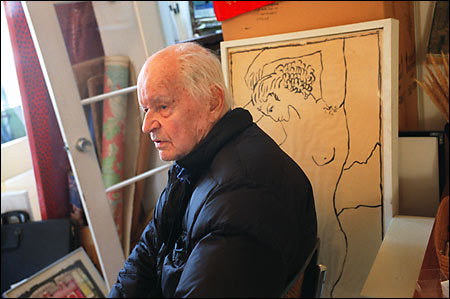Designer, painter, teacher Soltan dies at 92

Jerzy Soltan, an architect and teacher who educated generations of students in the principles of modernist design, died at his Cambridge home on Sept. 16. He was 92.Soltan, the Nelson Robinson Jr. Professor of Architecture and Urban Design Emeritus at the Graduate School of Design (GSD), was born in 1913 into an aristocratic Polish family in pre-Revolutionary Russian-occupied Latvia. He studied architecture at the Warsaw Technical Institute in Poland. It was there that he first became acquainted with the work of the great modernist designer Le Corbusier.Shortly after receiving his master’s degree, however, he was drafted into the Polish army, captured by the Germans, and placed in a German prison camp where he spent the remainder of the war. He occupied his time corresponding with Le Corbusier and translating one of his books. When the war ended, Soltan went to Paris and worked for Le Corbusier’s architectural firm, remaining there for five years.In 1949, he decided to return to Poland, now under Communist leadership, to help with the rebuilding of the country. For more than 15 years, he held a professorship at the Academy of Fine Arts in Warsaw. However, his ties with modernism and with Le Corbusier made him unpopular with the school’s Communist leadership. For a while, he was permitted to teach only bricklaying and carpentry.Soltan first came to the GSD in 1959 as a visiting critic, at the invitation of then-Dean Josep Lluís Sert. He was shortly thereafter named Professor of Architecture and served as chairman of the Department of Architecture from 1967 to 1974. Throughout his tenure at the GSD, Soltan was an enthusiastic advocate for the design philosophy of Le Corbusier, which he summarized as “an architecture of imagination, metaphor, poetics.”Soltan was instrumental in persuading his former employer to accept a commission to design the Carpenter Center. The reinforced concrete building on Quincy Street with its distinctive ramp is the only Le Corbusier building in North America. Fluent in Latvian, Polish, Russian, French, Italian, Spanish, and English, Soltan was able to serve as a guest critic and lecturer at universities all over the world. He also maintained an architectural practice and pursued his own work as a visual artist and painter. In 1968, with fellow architect and GSD professor Albert Szabo, he designed a house at Laconia, N.H., and in 1970, he worked on blueprints for Salem High School.The recipient of numerous awards and honors, he was awarded the Topaz Medallion of Excellence in Architectural Education in April 2002, presented jointly by the American Institute of Architects (AIA) and the Association of Collegiate Schools of Architecture (ACSA).In awarding the medallion, which was presented at a ceremony at the GSD, the jury called Soltan “the epitome of the inspirational educator, bringing boundless energy and architectural vision to generations of future practitioners.”Among Soltan’s former students are many prominent architects and designers as well as many influential figures in architectural education. These include Alan Chimacoff of Princeton; Pierre Jampen of Université Laval, Quebec; and Michael Graves, Princeton professor, architect, and designer of popular housewares including the famous Alessi teakettle. “My students are all big shots in American architecture now,” Soltan remarked upon receiving the Topaz Medallion in 2002. “They are the ones who have pushed for this honor.”Soltan leaves a daughter, Johanna, a son, Karol, and two grandchildren.Funeral services were held here and in Warsaw. A memorial service will be held at Harvard later this fall.




